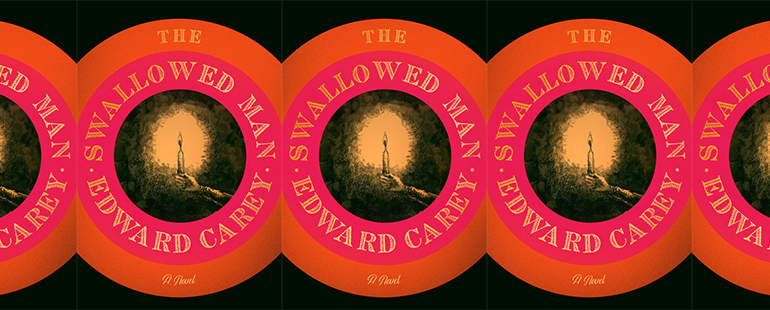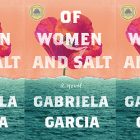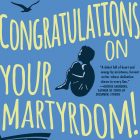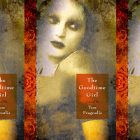“To write about Geppetto is to write about fatherhood, and at the same time he is a creator of a monster”: An Interview with Edward Carey

First published serially as “The Story of a Puppet” in 1881, then as the standalone The Adventures of Pinocchio in 1883, Carlo Collodi’s masterpiece of the mishaps of a wooden boy has since been translated into more than 300 languages and has spawned numerous films and television productions. It is such a fixture of culture that most authors would be too nervous to interact with it in any extended way. Edward Carey’s latest novel, The Swallowed Man, is audacious in this regard, as it launches directly from Collodi’s story, giving us the untold tale of Geppetto in bold illustration and dynamic, resonant text.
The beginning of the book focuses on how Geppetto, Pinocchio’s father, carved the boy from wood, gave him life, and began to teach him manners, words, and customs. After a few rebellious moments, including a punishable kick to the father’s shin, Pinocchio finally bends to Geppetto’s expectations and gains enough of his trust to attend school. But on his way one morning, Pinocchio gets caught up in the dangers and temptations of the outside world and disappears from his father’s sight. This is where Collodi and Carey’s works divulge: whereas the former takes on the rest of Pinnocchio’s story, the latter chooses to focus on Geppetto, waiting at home for the return of his son and eventually seeking him at sea, fearing he’s been lost to the waves. Geppetto is, of course, then swallowed by a monstrous shark—a creature so large that he finds in its belly a whole sailing ship, complete with provisions, shelter, candles, and the ink and paper to write out his plight.
Stuck in the beast, Geppetto spends the time longing for his son, worried over the boy’s success, and wallowing in regrets of fatherhood. He draws pictures of his lost Pinocchio. He recounts the love affairs that never provided such a real boy. He reminisces about his own father, about their relationship and the ways he failed him as an artist. He befriends a crab. He collects bits and bobs that come into the great fish with each gulp. Every day he works to shield himself from the perpetual slow rain of the bodily ceiling. He even attempts to build himself another boy, though this dim sculpting only leads to the birth of a chaotic, charred figure who runs amok, as well as to the birth of Otto, who is complacent and made entirely of pottery shards.
Carey has a knack for beautifully connecting objects to characters, in addition to weaving artwork—literally and figuratively—into his writing. In the Iremonger Trilogy, his characters are directly mated with household objects; in The Swallowed Man, this symbiosis between living and non-living is further blended. As Geppetto rides about the ship in the beast’s belly, painting portraits of those he loves, sculpting his losses, his emotions become clearly bound to these artistic creations:
I shall scrimshaw this tooth. Scrimshaw: might it be the most beautiful word in the whole language? Though it suggests too much time on one’s hands. It is the occupation of the listless. Art comes from doldrums. Sailors with sharp points carve time on bone. But what to carve? I thought at first of a whaling scene, depicting the creature being destroyed. I’d draw vengeance on its own bone. But now I think I should rather like to see some flowers here. I shall, with sharp point, drill cut flora upon it. To defeat the object that way, to change its purpose.
This notion of changing our surroundings, both our structures and our relationships, highlights a wonderful intricacy of The Swallowed Man, where Carey constantly places one element inside another—a story inside a story, a sailing ship inside a sea creature, his own plot within Collodi’s. This nesting allows Carey to explore the father’s perspective while the boy’s misadventures roil elsewhere. Geppetto’s dark imprisonment brings introspection, a deep focus on the guilt and difficulty of those left behind, a winnowing journey that is a part of life, even if it is brutal. “I have tried to get out,” Geppetto says. “I have made many attempts. But I must conclude that it is not possible. I am trapped within an enormous creature and am slowly being digested. I have found a strange place to exist, a cave between life and death. It is an unhappy miracle. I am afraid of the dark. The dark is coming for me.”
In the end, The Swallowed Man is a wrenching take on the indefatigable nature of time, the restless way in which parents seek the best for their children, often spurning themselves in quiet darkness, not knowing if they did right by their offspring. Alongside the dwindling crates of candles are Geppetto’s diminishing hopes of escape and the growing madness of his captivity. In the short time spent with Pinocchio, Geppetto experienced a compressed fatherhood of birth, newborn innocence, toddler rebellion, and teenage angst. Now, in two years of shark-capture, he is forced to look into his own tangled morals, his erratic behaviors, and grainy memories. Did he raise Pinocchio right? Did he prepare him for the world? Will his son make it? As the candles wane, we glimpse the last of Geppetto, shared with us in words and artwork: “Remember death. Ay, yes, I do not forget! Solemnly, every day, I prepare my rickety carcass. I, so to speak, pack my bags. I stare at my own exit.”
J.A. Tyler: Can you talk about how this novel, which grew out of an exhibition, came about?
Edward Carey: I was a writer-in-residence at one of Italy’s leading children’s hospitals, in Florence—Carlo Collodi lived in Florence and the hospital has images of Pinocchio all around it. I wrote some articles for Italian newspapers about my time there and from that the Collodi Foundation invited me to do an exhibition at the Parco di Pinocchio (a theme park dedicated to Pinocchio) in the town of Collodi (Carlo Collodi’s real name was Carlo Lorenzini. He spent a lot of time in Collodi and took his pen name from it. You can still visit the enormous oak tree there that Collodi used as the tree from which the Cat and the Fox hang Pinocchio in chapter 15). I said yes instantly and read and reread the book. I was amazed to find that Geppetto spends two years inside the belly of the enormous shark, but Collodi doesn’t write about this experience at all; the narrative forgets about Geppetto until it’s time for Pinocchio to rescue him. This makes sense, of course—it’s Pinocchio’s tale, not Geppetto’s. But I began to wonder about those two years and how Geppetto would spend that miserable time. I decided to make the artwork that I supposed Geppetto would create to keep himself sane. Then I thought that I should write his journal of captivity, too, and that the illustrated journal should be the catalogue to the exhibition.
JAT: What does a writer-in-residence at a children’s hospital do?
EC: I was shown around the hospital and could talk to anyone. The brief was to fully comprehend the place entirely. This is an incredible hospital and it felt like no other hospital I had ever been in before. It didn’t even smell like a hospital. There were clowns working there and dogs and musicians. I talked with cleaning staff, with people in the laundries, with nurses and surgeons. I sat in the background on doctors’ meetings, I met with psychologists, and went around the wards. Most of all, I talked with many children. We played games together and they showed me their drawings and we talked about stories and writing. It was an incredibly moving experience. I was out of my depth and enormously privileged to have had this experience. Pinocchio was everywhere, and there was the constant reminder that he is a child set apart from others.
JAT: For The Swallowed Man as well as your previous illustrated works, does the creation of the artwork and the writing happen simultaneously, or does one inform the other?
EC: They come together. One pushes the other on. I’ll be writing something and suddenly want to draw or sculpt it, and then that changes the writing. I try to dare them both to go further. And it’s an escape too. To get away from writing I draw and vice versa. Sometimes when I get stuck with the writing I just draw for days.
JAT: The novel’s illustrations include drawings and sculptures. Did one mode call out louder when you were working on this project?
EC: I sat in a dark corner in our house and wrote this book as if I was in some sort of isolation and I tried to dare myself to imagine what artwork Geppetto, who is an artist—he made his son after all—would make to keep alive. What mattered most to him. To begin with I just drew in ink and then I realized Geppetto would probably quickly run out of ink, so then he’d use squid ink, and I started drawing with squid ink. I made the artwork as I wrote—or as close to it as possible—so that I could try and feel what I thought Geppetto was feeling. Tracing the face of his son was the hardest thing, but I sort of dared myself to do it. Why not make three busts made of the ground ship’s biscuit? All right, I’ll do it.
Fortunately, Collodi had the shark swallow a ship before Geppetto arrived so that the old man could have a home inside the belly and some supplies. And slowly I populated my space with the objects that I thought Geppetto would have in his terrible isolation, a sort of family of objects. I started small and got larger and larger. He would make paintbrushes, I decided, from the hair of his beard. I wanted to make those brushes, but I am incapable to beard growth, so I asked a hairy friend if he’d cut me some bushels from his chin, and he very kindly obliged.
The busts were the hardest, but I knew I had to feel the faces Geppetto made for myself. One day I saw a huge bone in an antique shop and bought it, and knew immediately that Geppetto would find this huge bone in the shark and would paint a skyscape on it, so he could have a window to look out of.
JAT: Since March, you’ve been posting a drawing a day, which have included animals, objects, and famous, infamous, and imagined persons. How has this project helped you endure the pandemic? And is writing as compulsive for you as art (or as sustaining)?
EC: I didn’t quite know what I was getting in when I started and now I’m nearly 300 drawings in, 300 days. It’s a way to measure time now, I suppose. It’s a pandemic diary. It has helped me a lot. It’s a sort of a way of saying hello to people once a day, and people have asked me to draw certain things, and so there was communication again. It’s a little bit of peace in every day. Sometimes I draw to commemorate, or to mark a day’s event, sometimes to travel, to go back home to England, or to draw my heroes or monsters. Anything really. It’s a soup. For me, each little sketch gives me a little bit of hope. Marks on the page, small traces of existence. One more day closer to the end of this difficult time. Writing is as compulsive for me, but often a drawing comes first. That’s the start, suggestions made by a pencil.
JAT: The notion of fatherhood, of raising children, dominates the novel in many ways. Do you think this particular emphasis comes more from you or from Collodi? Or is it a mixture of both?
EC: A mixture of both, I think. To write about Geppetto is to write about fatherhood, and at the same time he is a creator of a monster, like Frankenstein. Geppetto learns, rather awkwardly, to think like a father and to grieve and love like a father. That is his journey in the book. Pinocchio—is he the greatest of all objects in literature?—is endlessly yearning to be a human, a living thing. In the book he is perpetually asking, What is a human being and how can I be one? I thought Geppetto, starved for company, forgotten and thrown away, deep inside a living cave, would wonder also: What is a human being and am I still a human being even now, after I’ve lost sight of one for so long? He yearns to find his son—in some ways to be forgiven, but also he wants to recuse him. But he can’t get out. It is a terrible agony.
JAT: Do you have a favorite translation of Pinocchio? One that you think speaks best to the original?
EC: I love Geoffrey Brock’s. It seems to capture Collodi’s strange voice and sense of play. I have collected several editions of the book in Italian and English, each with different illustrators. Unlike the Alice books that had [John] Tenniel’s definitive illustrations, or The Wind in the Willows and Winnie-the-Pooh, that had E. H. Shepard’s, I’m not sure Pinocchio has an illustrator that best captured the book. Perhaps Attilo Mussino came closest.
JAT: How do you feel about the Disney film version released in 1940? Does it do the book justice?
EC: It’s not that it’s a bad film—there’s some wonderful work in it—but it is not Collodi’s Pinocchio. The puppet is sweet and wet in the film but in the book he’s an uncontrollable lifeforce and a delinquent. Geppetto in the book is not sweet either; he has a foul temper and he made his puppet to earn money from him. The cricket is smashed to death with a mallet by Pinocchio in chapter four. Pinocchio’s feet do not get burnt off in the film, nor is he hanged by the Cat and the Fox. There is certainly a sense of danger, but not, for example, the horror of Lampwick as a donkey starving to death. The book is brutal and dark and beautiful and strange and full of life.
JAT: The Iremonger Trilogy features rooms within rooms, houses within houses, and The Swallowed Man also presents one thing inside another. What stirs you to write about these conjoined or nested structures?
EC: I think it might be the house I grew up in. It was an old building and most of it was Tudor but the foundations were supposed to be of a Saxon Hall, and a new part was added to it in the late eighteen hundreds so that the building seemed to contain so much time, layers and layers of it.
JAT: In Elmore Leonard’s 10 Rules of Writing, he said of the exclamation point “you are allowed no more than two or three per 100,000 words of prose,” though he used them 16 times that across his own works. How have you become so fearless with the exclamation point?
EC: Ha! When I lived in England I barely dared to use it and thought it a dreadful thing and in very poor taste, but living in America, where it seems to me more liberally used, I’ve grown to like it. If I moved back home, I probably shouldn’t take it with me.
JAT: As an artist, writer, and illustrator, what graphic novels or illustrated works do you love?
EC: I love Monster Portraits by Del Samatar and Sofia Samatar and My Favorite Things is Monsters by Emil Ferris. As a child I was shown William Hogarth’s work and I haven’t stopped studying it since. There are a few writer/illustrators that I adore and keep me going: Lynda Barry, Bruno Schulz, Maurice Sendak, Alasdair Gray, and, patron saint of all writer/illustrators, William Blake.
This piece was originally published on January 26, 2021.



